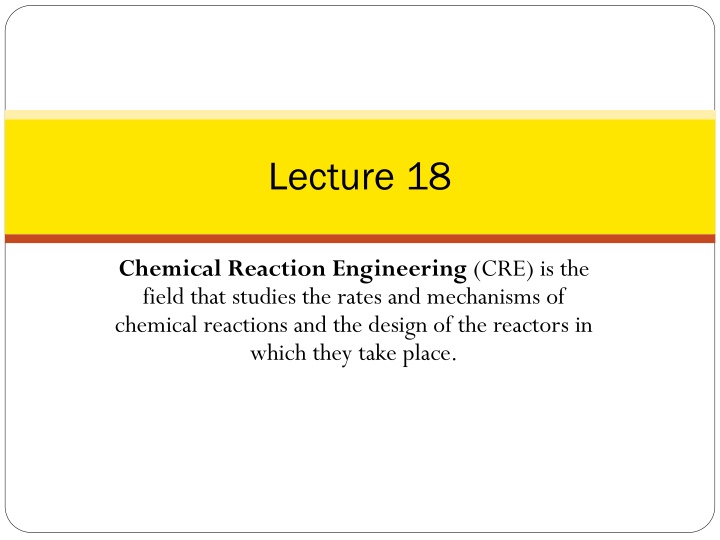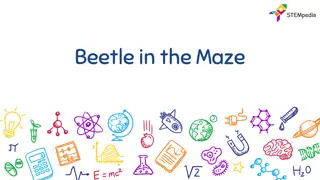
Exploring Catalytic Mechanisms in Chemical Reaction Engineering
Delve into the intricate world of catalytic mechanisms within the realm of Chemical Reaction Engineering (CRE). Discover the rates, mechanisms, and designs behind chemical reactions and reactors. Uncover the complexities of various reactions and their catalytic paths, including data analysis and vapor deposition. Explore how variables such as site concentrations, conversions, and adsorption play crucial roles in understanding and optimizing chemical processes.
Download Presentation

Please find below an Image/Link to download the presentation.
The content on the website is provided AS IS for your information and personal use only. It may not be sold, licensed, or shared on other websites without obtaining consent from the author. If you encounter any issues during the download, it is possible that the publisher has removed the file from their server.
You are allowed to download the files provided on this website for personal or commercial use, subject to the condition that they are used lawfully. All files are the property of their respective owners.
The content on the website is provided AS IS for your information and personal use only. It may not be sold, licensed, or shared on other websites without obtaining consent from the author.
E N D
Presentation Transcript
Lecture 18 Chemical Reaction Engineering (CRE) is the field that studies the rates and mechanisms of chemical reactions and the design of the reactors in which they take place.
Web Lecture 18 Class Lecture 23 Tuesday 4/16/2013 Catalytic Mechanisms Data Analysis Chemical Vapor Deposition (CVD) 2 2
Catalytic Mechanisms B+C 2A cat (a) The initial rate of reaction is shown below (A) (B) (C) 3 3
Catalytic Mechanisms A B+C (A) (B) kPA kPA rA= rA= 1+ KAPA+KCPC ( ) 1+KAPA+KBPB (A) B S+ C B S (B) B+ C S C S A+S A+S A S A S A S A S B+S C+S 4 4
Catalytic Mechanisms 2A B+C (C) (D) 2 2 kPA kPA rA= rA= )2 )2 1+KAPA+KCPC ( 1+KAPA+KCPC ( (C) B+C S C S (D) B+S+ C S C S A+S A+S A S A S A S+ A g ( ) A S+ A S C+S C+S 5 5
Catalytic Mechanisms 2A B+C A+S A S A S+ A S B+ C S C S C+S 2 kPA r A= )2 1+ KAPA+KCPC ( 6 6
Catalytic Mechanisms 2 4PA r A0= 1+ 4PA0+ KCPC0 mol For PC0= 2 atm and PA0=1 atm, then r A0= 0.0138 kgcat s 4 r A0= )2= 0.0138 1+ 4 + 2KC ( One equation and one unknown KC= 6 atm 1 2 4PA r A0= 7 )2 1+ 4PA+ 6PC (
Catalytic Mechanisms 2A B+ C CA S= KAPACV r A=rA0=kAPACV CA S A+S A S KA A S+ A S 2 r A=rS= kSCA S B+S+C S C S rA=rDC= kDCCC S PCCVKC CC S= KCPCCV C+S Where KA= 4 atm 1and KC= 6 atm 1 1) At what is the ratio of sites with A adsorbed to those sites with C adsorbed when the conversion is 50%? 2) What is the conversion when the sites with A adsorbed are equal to those with C adsorbed? 8
Catalytic Mechanisms 2A B+C B 2+C A 2 KA= 4 and KC=6 Ratio of site concentrations CA S CC S KC PC CV PA=PA01 X ( =KA PA CV =KA PA KC PC ) 1+ X ( X 2 1+ X ( 1 X 1+ X P0 X 2 1+ X P0 ) PC=PA0 ) P KA PA0 ( ) =2KA1 X KC X CA S CC S = P KC PA0 9 9
Catalytic Mechanisms 1) At X = 0.5 2 ( ) 4 ( )1 0.5 ( 6 0.5 ( ) CA S CC S =~ =1.33 ) 2) At an equal concentrations of A and C sites, the conversion will be ( ) 2 ( ) 4 ( ) 6+ 2 ( ) 4 ( )=8 =1=2KA1 X CA S CC S 2KA , then X = = KC+2KA KC X 14 X =0.57 10
Dimethyl Either 2CH3OH CH3 O CH3+ H2O 2ME DME +W Initially water does not exit the reactor the same as DME because Which of the following best describes the data A There is more DME than water. B Steady state has been reached. C Water reacts with ME. D Water is adsorbed on the surface. 11
Chemical Reaction Engineering in the Electronics Industry ChE 342 Czochralski Crystal Growth Heat Transfer Doping of n/p junction Diffusion ChE 344 Chemical Vapor Deposition (Catalysis Analogy) Photo Resist Formation Photo Resist Dissolution Etching The 5 steps 1. Postulate Mechanism (sometimes first includes a gas phase reaction (then adsorption, surface reaction and desorption) 2. Postulate Rate Limiting Step 3. Evaluate Parameters in Terms of Measured Variables 4. Surface Area Balance 5. Evaluate Rate Law Parameters
Chemical Reaction Engineering in the Electronics Industry 14 14
Chemical Vapor Deposition 1) Mechanism Gas Phase Homogeneous SiH4 rSiH4=kSiH4PSiH4 PH2PSiH2 SiH2+H2 KP Heterogeneous SiH2+ S rAD= kAPSiH2fV fSiH2 SiH2 S KSiH2 SiH2+ S S + H2 rDep= rS= kSfSiH2 fV = fraction of surface that is vacant 17
Chemical Vapor Deposition 2) Rate Limiting Step rDep=rS=kSfSiH2 3) Express fiin terms of Pi rAD kA 0 fSiH2=KSiH2fVPSiH2 4) Area Balance 1=fV+fSiH2=fV+KSiH2PSiH2fV 18
Chemical Vapor Deposition 4) Area Balance 1=fV+fSiH2=fV+KSiH2PSiH2fV 1 fV= 1+KSiH2PSiH2 5) Combine rDep=kSKSiH2PSiH2 1+KSiH2PSiH2 19
Homogeneous Reaction rSiH4=kSiH4PSiH4 PH2PSiH2 SiH4 SiH2+H2 KP rSiH4 kSiH4 0 PSiH2=KPPSiH2 PH2 kSKPKSiH2PSiH4 PH2+KSiH2KPPSiH4 k1PSiH4 PH2+K1PSiH4 rDep= = 20 20
End of Web Lecture 18 End of Class Lecture 23 21 21






















